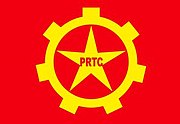| Revolutionary Party of the Central American Workers Partido Revolucionario de los Trabajadores Centroamericanos | |
|---|---|
| Founded | 1975 |
| Ideology | Revolutionary socialism Anti-imperialism Centroamerican unionism |
| Political position | Left-wing |
| Colors | Red |
| Party flag | |
 | |
The Revolutionary Party of Central American Workers (Spanish: Partido Revolucionario de los Trabajadores Centroamericanos, PRTC) was a political party in Central America.
Ideology
The group that founded the PRTC was inspired by Marxism-Leninism, Che Guevara and the experiences of the Vietnamese national liberation struggle. The party was accused of Trotskyism by other revolutionary groups, an accusation that the party rejected.
History
The PRTC was founded in 1975, by a sector that had left the ERP-RN after the 1972 elections. Clandestine pre-congress meetings for the founding of PRTC were held in Costa Rica, Honduras and El Salvador in 1975. Provisional 'Zonal Leaderships' were formed in these countries. The party also formed cells in Mexico and the United States. Contacts were established with activists in Belize, Guatemala, Nicaragua and Panama. In April 1975 the Liberation League was founded as a multisectoral mass front, which was to become a front organization for the party. In December 1975 the plenary session of the party congress was opened with delegates from around Central America. The PRTC was formally founded in San José on January 25, 1976. Fabio Castillo Figueroa became the General Secretary of the party. The party adopted a democratic centralism as its organizational principle.
During the period of 1976-1978, the party built up organizational structures throughout Central America with the exception of Nicaragua. The leadership was based in Costa Rica. In Guatemala, several of the leaders of the party would later join ORPA. In El Salvador, the Zonal Leadership was made up of Mario López (a.k.a. Comandante Venancio, Zonal Secretary), Manuel Federico Castillo, Luis Díaz, Humberto Mendoza, Nidia Díaz and Joaquín Morales Chávez.
The second party congress of PRTC was held in Tegucigalpa in April 1979. The congress elected Dr. José María Reyes Mata as the new General Secretary of the party. The congress also formed a Central American Political Commission as a new party leadership. The Commission had one member from each Central American country.
In 1979, the party set up a series of new mass organizations in El Salvador. The peasant sector of the Liberation League was converted into a separate organization, Brigadas de Trabajadores del Campo (BTC). Other new mass organizations were Brigadas Revolucionarias de Estudiantes de Secundaria and Comités de Base Obrera. The People’s Liberation Movement (MLP) was formed as an umbrella body of the mass organizations of the party. In January 1980 MLP was one of the organizations that founded the Coordinadora Revolucionaria de Masas, an alliance which would later found the Revolutionary Democratic Front in April 1980. In 1979, the party also launched an armed wing, Fuerzas Armadas de Liberación Popular.
In August 1980 the main leader of PRTC in El Salvador, Luis Díaz, 'disappeared'.
In October 1980 a PRTC Central Committee meeting was held in Managua. The meeting dissolved the Central American structures of the party, converting the national party branches into separate parties. As a continuation of the unified PRTC, the meeting set up a Conference of Revolutionary Parties in Central America as a coordinating body of the individual PRTC. This shift was necessary for the Salvadoran branch of PRTC to be able to join the FMLN. The Salvadoran PRTC became one of the members of the FMLN guerrilla movement on December 5, 1980. The Honduran PRTC continued armed struggle of its own.
References
- ^ "CeDeMA".
- "El Salvador". www.areitodigital.com. Archived from the original on 2010-03-17.
- "Honduras Insurgency 1981-1990". Archived from the original on 2015-01-12. Retrieved 2009-07-06.
- 1975 establishments in North America
- 1980 disestablishments in North America
- Communist parties in Costa Rica
- Communist parties in El Salvador
- Communist parties in Guatemala
- Communist parties in Honduras
- Communist parties in Nicaragua
- Communist parties in Panama
- Defunct political parties in Belize
- Defunct political parties in Costa Rica
- Defunct political parties in El Salvador
- Defunct political parties in Guatemala
- Defunct political parties in Honduras
- Defunct political parties in Nicaragua
- Defunct political parties in Panama
- Far-left political parties
- History of Central America
- Marxist parties
- Organizations of the Salvadoran Civil War
- Paramilitary organizations based in Honduras
- Political parties disestablished in 1980
- Political parties established in 1975
- Transnational political parties